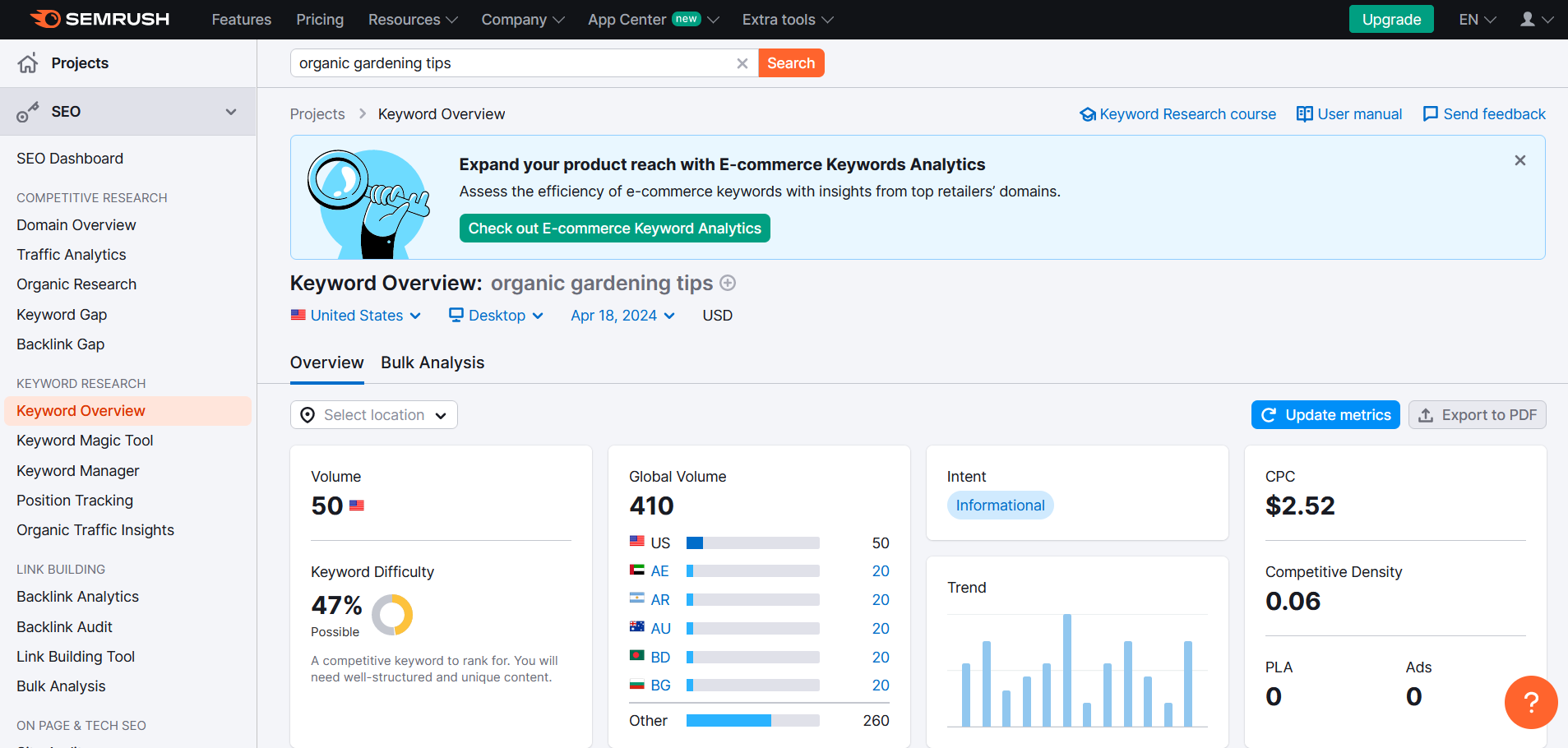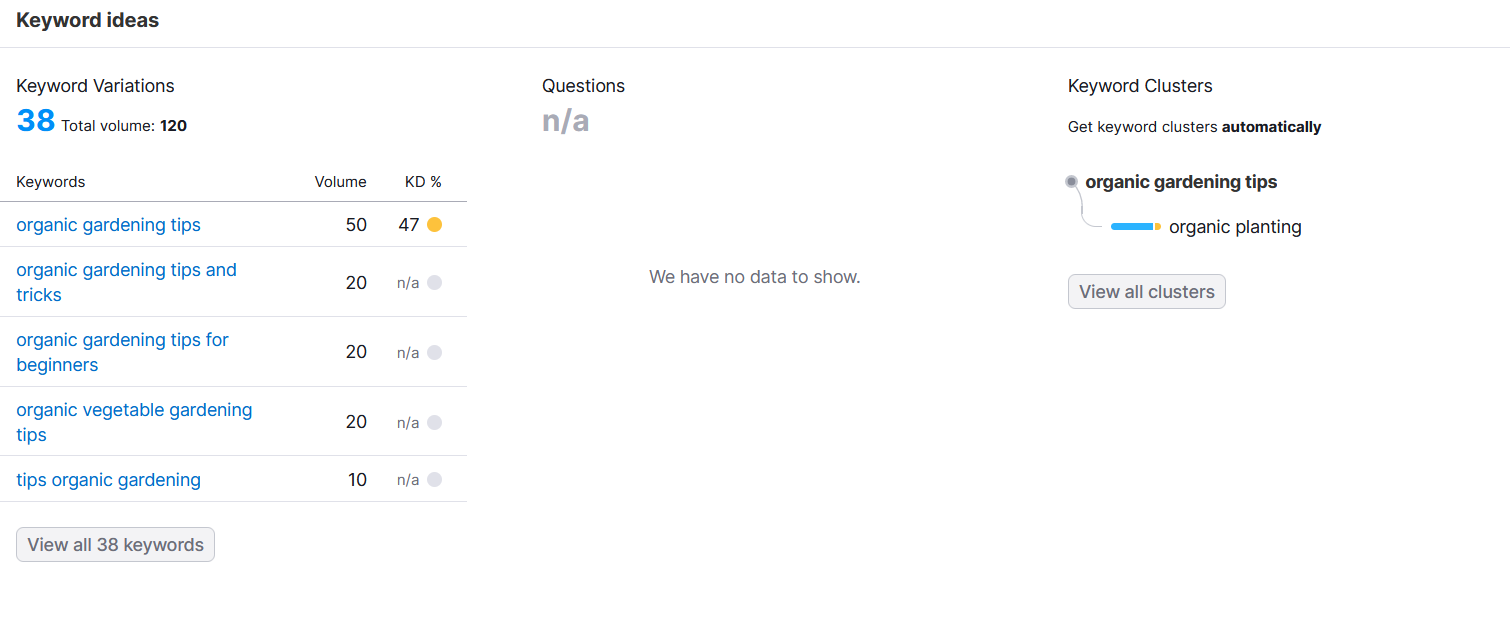How to Optimize Your Content for Search Engines

Crafting content that resonates with your target audience and achieves strong search engine visibility requires more than just captivating prose. Understanding and skillfully applying search engine optimization (SEO) best practices is essential for ensuring your content reaches the people who are most interested in what you have to say. By familiarizing yourself with core SEO strategies and seamlessly integrating them into your content creation process, you empower your content to find its ideal audience and flourish online.
Whether you're a passionate blogger pouring your heart into informative articles, a small business owner determined to attract new customers, or part of a larger marketing team working collaboratively to reach a wider market, mastering the fundamentals of SEO will equip you to transform your content into a powerful tool for building genuine connections with your ideal readers.
Here's how you can get started -
1. Get to Know Your Audience and Their Search Intent
Before you even begin writing, it's crucial to understand who your audience is and what they are searching for. It involves identifying the keywords and phrases they use when looking for information in your niche. Delving into audience demographics and behavioral patterns can refine your understanding and improve your content's relevance.
Tools like Google Keyword Planner, Ahrefs, or SEMrush can help you research and choose relevant keywords with a good balance of search volume and competition. These platforms also provide insights into keyword difficulty and potential return on investment, which can guide your content strategy to target the most opportune terms.
For instance, using SEMrush, you could explore the keyword "organic gardening tips" to see its monthly search volume, trend data, and competitive density, providing valuable insights to shape your content strategy effectively.

These tools offer a look and keyword ideas at the competitive landscape for your chosen keywords, allowing you to devise ways to differentiate your content from others in your sector.

2. Use Keywords Strategically
Once you have your keywords, including your focus keyword, "organic gardening tips," it's essential to use them strategically throughout your content. Incorporating them into high-impact positions like the introduction, conclusion, and significant headings can enhance your SEO effectiveness. Ensure you integrate keywords naturally into your text to keep it readable and engaging, avoiding keyword stuffing, which can negatively impact the user experience and SEO rankings.
Here are a few key places to include them -
1. Title Tag - Use your focus keyword in the title tag to help search engines understand your content.
2. Meta Description - Although it doesn't directly impact your SEO rankings, a compelling meta description can improve click-through rates.
3. Headings and Subheadings - Using keywords in your headings helps break down your content into digestible sections and boosts SEO.
4. In the Body - Ensure that your keywords appear naturally within the first 200 words and throughout your content at a 1-2% keyword density.
3. Optimize Content Structure for SEO
How you structure your content dramatically affects how well it performs in search engine rankings. When your content is well-organized with clear headings, subheadings, and bullet points, it makes reading more accessible for your audience. It helps search engines categorize your content effectively. Crafting concise, keyword-rich URLs can boost your content's visibility and performance in search results.
You can further optimize your content for better search engine visibility by incorporating relevant keywords into your headings and subheadings. It increases the likelihood of your content ranking higher in search results, making it more accessible to your target audience. Using schema markup benefits your content. It improves content relevance in search results, driving more clicks and customer engagement.
Here are some tips to optimize your content -
1. Readable Length - Long-form content, typically 1,500 to 2500 words, tends to rank higher on search engines. Ensuring that your content remains engaging and well-structured throughout its length is crucial.
2. Short Paragraphs - Breaking your content into shorter paragraphs makes it more digestible for readers, especially when consuming content online. Aim for paragraphs of 2-3 sentences each to maintain reader interest and flow.
3. Bullet Points and Lists - Incorporating bullet points and lists into your content helps organize information effectively. This formatting style makes it easier for users to scan your content, quickly identifying key points or takeaways.
💁♀️ Also read - SEO vs. SEM: Understanding the Differences and When to Use Each
4. Optimize Images and Videos
Visuals are crucial for engagement, but they also need to optimize your content for SEO -
1. Alt Text - Describe your images and videos with alt text using relevant keywords. It improves accessibility and SEO.
2. File Names - Include keywords in your file names to help search engines understand and rank your content better.
3. Compression - Reduce file sizes to enhance load times, directly affecting your SEO rankings.
On top of these improvements, think about fine-tuning image and video formats to make your website smoother. Regularly checking visual content and giving it a refresh ensures it stays relevant and in line with the latest SEO standards. Implementing structured data markup for images and videos adds more context for search engines, potentially giving your site a leg up in rankings and visibility.
5. Link Building and Internal Links
Link building is an essential aspect of SEO. It involves acquiring links from other websites to your own, indicating to search engines that your content is valuable and authoritative. To effectively build links, focus on creating high-quality, shareable content that naturally attracts backlinks from reputable sources.
For example, a study conducted by Backlinko found that the number of referring domains to a page correlates strongly with its position in Google search results. Therefore, investing in effective link-building strategies can significantly impact your website's visibility and organic traffic. You can read types of traffic sources to understand them better.
Actively engage in outreach efforts to connect with relevant websites and encourage them to link to your content. Monitor your link profile regularly and disavow any toxic or irrelevant links that could harm your SEO efforts.
Here's how to approach it -
1) Internal Linking - Internal linking strategically connects pages on your website, weaving a user-friendly navigational path that empowers visitors to delve deeper into topics of interest. By incorporating 5-8 relevant internal links within each piece of content, you're not just aiding search engines in indexing your site, you're providing users with a curated journey through your knowledge base. Consider the natural flow of your content and strategically insert links to relevant pages that offer more in-depth information or complementary perspectives on the subject matter.
Employ clear and descriptive anchor text that accurately reflects the content of the linked page. This not only enhances user experience by making it clear where clicking will take them, but it also demonstrates the depth of expertise present on your site and fosters trust with your audience.
2) External Links - Carefully selected external links to reputable sources act as cornerstones for building trust and enhancing the value of your content. By including 1-3 external links per page, you offer users valuable opportunities to explore expanded perspectives, delve deeper into supporting evidence, or gain insights from recognized authorities on the subject matter. Prioritizing links to primary sources such as research studies, government data, and official reports demonstrates a commitment to providing well-researched and reliable information, establishing your site as a trustworthy resource.
This focus on external links that uphold strong EAT (Expertise, Authoritativeness, and Trustworthiness) signals aligns with Google's guidelines for high-quality content, ultimately benefiting users who seek out informative and credible websites.
6. Optimize for Mobile and Loading Speed
With mobile devices driving most internet traffic, having a mobile-friendly website is crucial. For instance, over 60% of Google searches are on mobile devices. It underscores the importance of having a responsive design that adapts seamlessly to various screen sizes, providing users with an optimal browsing experience regardless of their device.
For example, Amazon reported a 1% decrease in sales for every 100 milliseconds of additional page load time. It underscores the critical importance of optimizing your website's loading speed for user satisfaction and SEO performance.
Page speed is a ranking factor -
1. Responsive Design - Ensure your website adjusts seamlessly to any screen size.
2. Compression and Caching - Utilize tools like JPEG Optimizer, Fotor, and Simple Image Resizer to reduce image file sizes and cache parts of your site, thus enhancing loading speed.

💡Related - Mobile App vs. Mobile Website: Making the Right Choice for Your Business
7. Regular Updates and Content Refreshes
Search engines favor regularly updated websites. Periodically refreshing your content can keep it relevant and maintain or improve your SEO rankings. For instance, updating blog posts with new insights or case studies can demonstrate your expertise and attract more visitors over time. Consider repurposing existing content into different formats, such as videos, infographics, or podcasts.
To reach a wider audience and keep your content fresh and engaging. You can also conduct user surveys or analyze feedback to identify areas for improvement and tailor your content to meet the needs of your audience better. Collaborating with industry influencers or experts to co-create content can provide valuable insights and perspectives while expanding your reach and authority in your niche.
8. Utilize Schema Markup for Enhanced SERP Appearance
Schema markup empowers search engines to understand the context of your content, thus enhancing how they represent your page in search engine result pages (SERPs). This added context can significantly improve your click-through rates and overall visibility in search results, resulting in more organic traffic to your website, with increased visibility and better presentation of search results.
Your website has a more significant opportunity to attract and engage with your target audience, ultimately driving more conversions and achieving your business goals. Structured data enables rich snippets like ratings, author info, or product prices, enhancing your listing for visitors. This increased visibility and enhanced presentation can lead to higher user engagement and interaction with your content.
9. Monitor and Analyze Your SEO Performance
SEO strategy is only complete with monitoring and analyzing its performance. Use tools like Google Analytics and Google Search Console to track how well your content is performing. These platforms offer insights into metrics such as page views, bounce rate, and average time on page, allowing you to understand user behavior in depth.
Look at metrics such as page views, bounce rate, and average time on the page to understand user behavior. Adjust your strategies based on this data to continually improve your site's SEO performance. For example, if you notice a high bounce rate on certain pages, consider optimizing their content or loading speed to enhance user experience and engagement.

Recommended read - Content Repurposing: Maximizing Your Efforts for Traffic and Engagement
10. Leverage Social Media to Boost SEO
While social media signals do not directly influence rankings, their visibility can lead to more search queries and increased traffic to your site. Regularly sharing your content on social media platforms can also lead to more backlinks as your content reaches a broader audience. Engaging with your audience on social media can foster relationships and brand loyalty.
You are indirectly impacting SEO by increasing brand authority and trustworthiness. Ensure your posts on social media optimize your content with relevant keywords and engaging visuals to capture attention and drive traffic back to your site. Consider using tools like Buffer or Hootsuite to schedule posts and analyze performance metrics.
Final Thoughts
Making your content shine on search engines is a straightforward process that strategically yields powerful results. To optimize your content for search engines, understand your audience's needs and interests. This will guide your choice of keywords, the terms they're searching for – to incorporate seamlessly throughout your content. Ensuring that your website's technical health aligns with SEO requirements is crucial. This encompasses aspects like fast loading speeds, a mobile-friendly design, and a clear site structure. These factors contribute to a positive user experience and help search engines easily understand your website, increasing visibility and attracting more visitors.
Remember, search engine optimization (SEO) is a dynamic field. Staying informed about the latest algorithm updates, trends, and best practices is essential to maintain and improve your search rankings in the competitive online landscape.